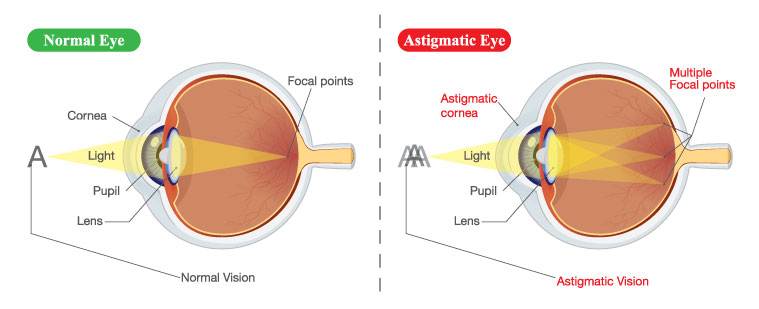Key Takeaways
- Understanding Astigmatism: Astigmatism, described as an irregular eye shape causing blurred vision, affects both near and far vision, leading to symptoms like squinting and headaches.
- LASIK for Astigmatism: LASIK surgery corrects astigmatism by reshaping the cornea for improved vision clarity, offering benefits like customized treatment and fast recovery.
- Candidacy Criteria: Eligibility for LASIK includes having a stable vision prescription, sufficient corneal thickness, and no significant eye diseases, among other requirements.
- Surgical Process: The LASIK procedure involves creating a corneal flap and reshaping the cornea with a laser to correct astigmatism, followed by flap repositioning without sutures.
- Recovery and Care: Post-operative care for LASIK includes managing discomfort with medication, attending follow-up appointments for vision monitoring, and adopting lifestyle adjustments for healing.
- Addressing Concerns: LASIK can effectively eliminate astigmatism for most patients, though recovery timelines and outcomes vary, with a small risk of complications which should be discussed with the surgeon.
Introduction to Astigmatism and its Impact on Vision
Understanding Astigmatism: Causes and Symptoms
Astigmatism is when the eye is shaped more like a football than a perfectly round ball. This makes things look blurry or wobbly because light doesn’t focus in the eye like it should. Imagine if you’re trying to shine a flashlight on a spot, but instead of one clear spot, you see a smudge or a blur. That’s what happens with astigmatism; the eye doesn’t make a clear “spot” for you to see sharply. Unlike nearsightedness which affects vision mainly for distance or farsightedness which affects vision mostly for near, astigmatism affects both near and far vision.
Symptoms may include:
- Squinting
- Blurred vision at all distances
- Light halos or “starbursts”
- Difficulty with night vision
- Eyestrain or discomfort
- Headaches
Different types of Astigmatism: Regular vs Irregular
Astigmatism can be categorized into two main types:
- Regular Astigmatism: This is the most common form of astigmatism. It occurs when the principal meridians, representing the two lines of steepest and flattest curvatures on the cornea, are perpendicular to each other. In simpler terms, the cornea is curved more in one direction and flatter in another, giving it a shape similar to a football. Regular astigmatism can be corrected using eyeglasses, contact lenses, or refractive surgeries like LASIK or PRK.
- Irregular Astigmatism: Less common than regular astigmatism, irregular astigmatism occurs when the principal meridians aren’t perpendicular to each other. This results in irregular curvature of the cornea in multiple directions. It could be the result of eye conditions like keratoconus, corneal scarring or traumatic eye injuries. Correcting irregular astigmatism can be more challenging than its counterpart and may necessitate specialized solutions such as custom-made contact lenses, specifically scleral lenses or Topography-guided LASIK or PRK.
Impact of Astigmatism on Visual Acuity and Quality of Life
Uncorrected astigmatism can significantly impact visual acuity and quality of life, impacting daily activities such as driving, reading, and using electronic devices. The effect of astigmatism on visual acuity and daily life can vary depending on the severity of the condition. It also affects both the near and far vision.
Importance of Seeking Treatment for Astigmatism
Addressing astigmatism through treatments such as contact lenses or LASIK astigmatism surgery can improve visual clarity and enhance overall quality of life. By addressing it, individuals can regain sharper vision and alleviate symptoms, allowing them to engage more comfortably in daily tasks.
Overview of LASIK Surgery for Astigmatism
What is LASIK and How Does It Work?
LASIK (Laser-Assisted In Situ Keratomileusis) is a widely performed surgery that reshapes the cornea using a laser to correct refractive errors such as astigmatism. It is typically performed as an outpatient procedure and is known for its rapid recovery time and high success rates in achieving improved vision without needing corrective eyewear.
How LASIK Corrects Astigmatism: Mechanisms and Benefits
LASIK corrects astigmatism by reshaping the cornea to achieve a more uniform curvature, allowing light to focus correctly on the retina. There are several direct benefits of the surgery, including:
- Customized Treatment: Advanced astigmatism surgery technologies, such as topography-guided LASIK and PRK, allow for personalized astigmatism correction and enable the surgeon to tailor the treatment to the individual’s needs.
- Enhanced Visual Acuity: LASIK surgery can significantly improve visual acuity and clarity by reshaping the cornea to correct astigmatism. Patients often experience sharper, clearer vision at various distances, reducing or eliminating the need for corrective lenses such as glasses or contact lenses.
- Fast Recovery and Long-lasting Results: LASIK surgery for astigmatism typically offers rapid visual recovery, with many patients noticing improvements in vision immediately after the procedure. The results of LASIK are also long-lasting, with most patients experiencing stable vision correction over time.
Correcting Mild Irregular Astigmatism with Topography-guided LASIK
Most people have some degree of irregular astigmatism. Although it is rarely severe enough to be classified clinically as such, it often causes some degree of visual distortion. This is the reason that procedures like topography-guided LASIK or Contoura, have been consistently shown to be superior in visual results to traditional LASIK. Topography-guided LASIK, or Contoura, creates detailed maps of the cornea’s surface, enabling the surgeon to tailor the treatment to the individual’s unique visual aberrations and corneal irregularities. The use of Contoura optimizes the outcomes of astigmatism correction.
Candidacy Criteria for LASIK in Treating Astigmatism
Patients must undergo a comprehensive eye exam to determine their candidacy for the procedure. General eligibility requirements:
- Vision prescription has remained relatively stable for at least one year.
- No significant eye conditions or diseases, such as glaucoma or severe dry eye syndrome.
- Corneas are thick enough to undergo the medical procedure safely.
- Astigmatism falls within the treatable range for LASIK correction.
- Good general health and no conditions that could interfere with healing or surgery.
Correlation of Surgeon’s Skill with Successful LASIK Surgery for Astigmatism
Choosing an experienced cornea specialist with expertise and a proven track record in successful LASIK surgery is essential for achieving optimal outcomes. A reputable surgeon prioritizes patient safety, provides thorough pre-operative evaluations, and provides comprehensive post-operative care, ensuring the best chances for long-term effective treatment.
Exploring Alternative Laser Eye Surgeries for Astigmatism
Comparison of LASIK, PRK, and other Laser Eye Surgeries
While LASIK is a widely performed procedure for astigmatism correction, the surgeon may recommend other options, such as PRK (Photorefractive Keratectomy) or SMILE (Small Incision Lenticular Extraction), in certain cases. Understanding the differences between these procedures is essential for making informed treatment decisions.
Correcting Significant Irregular Astigmatism with Topography-guided PRK
Topography-guided PRK is usually preferable for significant irregular astigmatism due to its ability to address complex corneal irregularities with customization and precision. Unlike LASIK, PRK does not utilize a thin flap but instead directly reshapes the corneal surface. This makes it well-suited for cases where the cornea is too thin or irregular for flap creation such as in keratoconus. In Keratoconus, before doing any type of corrective laser treatment on the eye the patient must have collagen cross linking first.
Advantages and Limitations of Each Procedure
Each refractive (corrective vision procedure) procedure has unique advantages and limitations, which should be carefully considered based on individual patient vision, health, and preferences. Consulting with an experienced cornea specialist is essential for determining the most suitable treatment option.
Tailoring Treatment to Individual Patient Needs
Personalized treatment plans are essential in addressing astigmatism, and made easier with the use of topography. A thorough evaluation and consultation process helps ensure the chosen treatment aligns with the patient’s goals and expectations.
Preparing for LASIK Surgery for Astigmatism
Pre-Surgical Evaluation and Consultation Process
Before LASIK surgery for astigmatism, patients must undergo a comprehensive eye examination to assess their candidacy and discuss treatment options. This includes evaluating refractive error, ocular health, and systemic health and thoroughly measuring the cornea.
Patient Education: Understanding Risks, Benefits, and Expectations
Understanding LASIK surgery risks, benefits, and expected outcomes is essential for informed decision-making. Clear communication between the surgeon and patient helps manage expectations, alleviate concerns, and ensure the process goes smoothly.
Preparing Mentally and Physically for the Procedure
Preparing mentally and physically for LASIK surgery involves following the surgeon’s pre-operative instructions, such as avoiding contact lenses, staying hydrated, and arranging for transportation on the day of the procedure. It is recommended that questions be written down before the first visit with the surgeon.
LASIK Procedure: Astigmatism Correction in Action
Step-by-Step Overview of LASIK Surgery for Astigmatism
During LASIK surgery, the surgeon numbs the eye with anesthetic drops and uses a laser (All Laser LASIK) or a circular blade (traditional LASIK) to create a thin flap on the cornea. The underlying corneal tissue is then reshaped to correct the refractive error.
- Pre-operative Evaluation: Before the surgery, the patient undergoes a comprehensive eye examination to assess their candidacy for LASIK.
- For Topography Guided LASIK or PRK or Contoura, a detailed map of the eye is first obtained. This map guides the laser to reshape the cornea to obtain the sharpest possible vision.
- Anesthetic: On the day of surgery, numbing eye drops are applied to ensure the patient’s comfort during the procedure.
- Creation of Corneal Flap: A thin flap is created on the cornea’s surface to access the underlying corneal tissue.
- Corneal Reshaping: With the corneal flap lifted, a specialized laser delivers pulses of ultraviolet light with extreme precision to reshape the exposed corneal tissue based on the patient’s specific refractive error.
- Flap Repositioning: Due to the cornea’s self-adhesive properties, the flap adheres to the underlying cornea naturally after it is repositioned, without the need for sutures or bandage lenses.
- Post-operative Care: Post-operative instructions may include using prescribed eye drops to promote healing, prevent infection, and avoid activities that may strain the eyes.
- Follow-up Appointments: Post-operative appointments allow the surgeon to assess visual acuity and corneal healing.
Role of Advanced Technologies in Enhancing Surgical Precision
Advanced technologies such as wavefront-guided (older technology, less commonly used today) and topography-guided treatments enhance the precision and accuracy of LASIK surgery, resulting in improved visual outcomes and reduced risk of complications.
Patient Experience: What to Expect During and After Surgery
LASIK surgery is typically quick and painless, with most patients experiencing improved vision immediately after the procedure. Mild discomfort and temporary side effects such as dry eyes and sensitivity to light are common during the initial recovery period.
Post-Operative Care and Recovery
Immediate Post-Surgery Recovery: Managing Discomfort and Symptoms
Following LASIK surgery, patients are advised to avoid strenuous activities for a few days. The surgeon may prescribe pain medication and lubricating eye drops to manage discomfort and promote healing.
Monitoring Vision Progression: Follow-Up Appointments and Check-Ups
Regular follow-up appointments are essential to monitor vision progression and address concerns. These appointments also allow for adjustments to the post-operative care regimen as needed.
Lifestyle Adjustments for Optimal Healing and Visual Rehabilitation
Adopting healthy lifestyle habits such as staying hydrated, avoiding eye strain, and protecting the eyes from UV exposure can promote optimal healing and visual rehabilitation following LASIK or PRK surgery.
Addressing Common Concerns and Questions
Can LASIK Fix Astigmatism Completely?
In most cases, Lasik can completely eliminate astigmatism, significantly improving visual acuity and quality of life. However, individual results may vary. In rare cases an enhancement procedure may be needed.
Managing Expectations: Realistic Recovery Timelines and Outcomes
While LASIK surgery offers rapid visual recovery for many patients, it’s important to understand that complete stabilization of vision may take several weeks to months. Realistic expectations and patience are key to a successful outcome.
Addressing Complications and Potential Risks Associated with Surgery
While LASIK surgery is considered safe and effective for most patients, as with all medical procedures, there are potential risks and complications to be aware of. These can include dry eye symptoms, glare, halos, under-correction, over-correction, and, in rare cases, more severe complications such as infection or corneal ectasia. Discussing these risks with the surgeon during the consultation process is crucial to ensure a thorough understanding of what to expect and how to minimize the likelihood of complications.
Success Stories and Patient Testimonials
Real-Life Experiences of Patients Who Underwent LASIK for Astigmatism
"I am looking forward to not wearing glasses or contacts anymore and go swimming. the procedure was so easy; piece of cake. I could see the clock without squinting. Dr. Cohen was very informative and made the whole experience pleasant. He walked me through everything. I am the biggest chicken, if I could do it, anyone can do it."

"Since I was four years old, I had been wearing thick glasses because of my high astigmatism. My wish had always been to see clearly without having to wear my glasses. The surgery has changed my life immensely. I chose Dr. Cohen for my LASIK because of his level of professionalism and his educational background. The surgery was easy, painless, quick and the minute he finished I was able to see perfectly without my glasses."

"I am an optometrist and chose Dr. Cohen for my cataract surgery with a multifocal lens implant because over the last 20 years of knowing him and referring many of my patients to him, he never made a mistake. I didn't feel a thing during the surgery. I couldn't be happier with my vision. I am happy with my choice of lens and excited that I never have to have anything done again!"

"Dr. Cohen came extremely recommended to me. I saw the results of other people that I know and really wanted to get a surgery too. I actually wanted to get it done a few times before, but he said, I am not ready yet, because I was abusing my contacts. I had to stop wearing them for a while. My vision a day after was 20/20. Thank you so much Dr. Cohen! You are a life saver."

"I work in Manhattan. I am an operating engineer. When I was 14 years old I needed a cornea transplant on my right eye. I really couldn't see well even after the surgery. I recently went to Dr. Cohen and he did a procedure on my right eye. It drastically improved my vision. I can actually street signs and news paper and television."

"I am looking forward to not wearing glasses or contacts anymore and go swimming. the procedure was so easy; piece of cake. I could see the clock without squinting. Dr. Cohen was very informative and made the whole experience pleasant. He walked me through everything. I am the biggest chicken, if I could do it, anyone can do it."

Impact of Improved Vision on Daily Life and Activities
The impact of improved vision on daily life and activities following LASIK surgery for astigmatism can be transformative. With clearer, sharper vision, individuals often find themselves more confident and capable in various aspects of daily life. Once challenging tasks like driving at night or reading small print become significantly more manageable and enjoyable.






